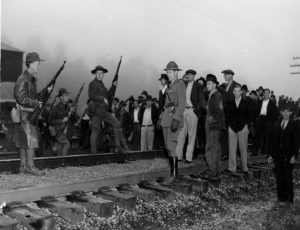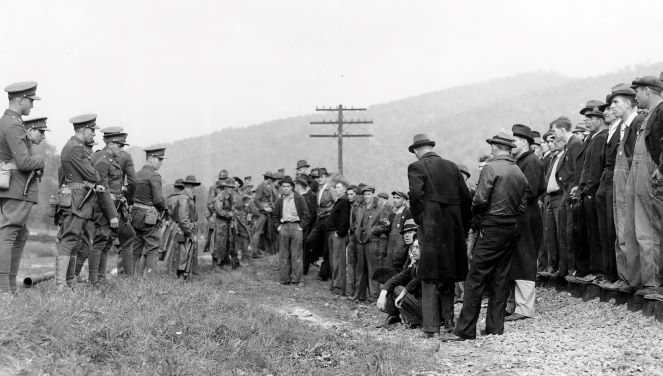**Photograph: A crowd of miners confronting soldiers – Harlan County, Kentucky 1939
My stage play, “Which Side Are You On: The Florence Reece Story,” debuted at Pellissippi State Community College on April 15, 2016. The play recounts episodes in the life of Florence Reece, an American social activist, poet, and folk song writer – and veteran of the bloody Harlan County, Kentucky, coal wars of the 1930s which pitted coal miners and union organizers on one side against the coal companies, hired gun thugs, and law enforcement on the other. The war included strikes, skirmishes, bombings, executions, and the occupation of Harlan County by both state and federal troops for more than a decade. The daughter and wife of coal miners, Reece penned the song “Which Side Are You On?” that became a social justice anthem after Pete Seeger recorded it in 1940.
One of the challenges of writing the play was the paucity of biographical information about Florence Reece. I knew some of the broad strokes of her life but was forced to imagine particulars supplied by research and interviews. Fortunately, I recalled stories told me by my grandmother about her father, my great-grandfather, a coal miner named William, aka “Kildee,” Thomas, who mined coal in southeastern Tennessee during the decades spanning the play. Consequently, I conflated both stories, my grandmother’s and Florence’s, as a way to depict the hardscrabble lives of miners and their families in the coal country of southern Appalachia.
To my thinking, three scenes best characterize Florence’s tenacious pluck and un-redoubtable determination. The first occurs when gun thugs riddle her home with gun fire after Florence anticipates their arrival and orders her six children to hide under the bed. Miraculously, no one was injured. In the aftermath, she tore a page from a wall calendar and scribbled lyrics of the now-famous protest song.
The second episode occurs at the Highlander Folk School, a social justice leadership training center founded in Monteagle Mountain, Tennessee, by Myles Horton and Don West in 1932. There Florence and her husband, Sam, encountered activist notables Reverend Will Campbell and Dr. Martin Luther King in September of 1957. Influenced by Mahatma Gandhi’s philosophy of non-violent, civil resistance, King provides his own version of Gandhi’s teaching with which Florence takes issue at once:
FLORENCE
Martin, this Gandhi feller – I read a newspaper piece that he said he was a lawyer with a first-class ticket on a train in India. But a station policeman ordered him back to third class. Just like Rosa [Parks].
MARTIN LUTHER KING, JR.
Yes.
FLORENCE
But Gandhi refused and was arrested.
MARTIN LUTHER KING, JR.
That’s right.
FLORENCE
So Gandhi arranged a – peaceful protest, what you called –
MARTIN LUTHER KING, JR.
Non-violent resistance.
FLORENCE
Us miners would call it a strike. Only Gandhi asked people in India to lay down on the railroad tracks to stop the train.
MARTIN LUTHER KING, JR.
Yes.
FLORENCE
And the trains stopped.
MARTIN LUTHER KING, JR.
Yes.
FLORENCE
The way I see it, Mr. Gandhi was pretty sure of the outcome before he got it. He counted on the British people to be civilized. Civilized people don’t run over people laying on the railroad tracks. But if you’re a striking miner in Eastern Kentucky and lay down in the road, you can count on some scab to run you over with his car.
The play’s climax takes place at the hospital bedside of Florence’s husband Sam, succumbing to the final stages of Black Lung disease. What follows is an imagined snippet of their final conversation:
SAM
Now what’s wrong, Florence?
FLORENCE
What do you mean what’s wrong?
SAM
Are you in a twitch because I’m dying?
FLORENCE
What do you think?
SAM
You knew it would come to this.
FLORENCE
Of course I knew it would come to this. Just not this way.
SAM
What way then?
FLORENCE
Did you ever think that all we did warn’t enough? That what we tried to do came to nought?
Sam Reece died in 1978 from the scourge of Black Lung. After a lifetime of advocating for social justice, Florence Reece died of a heart attack in 1986 at the age of 86 in Knoxville, Tennessee. However, Florence Reece’s “Which Side Are You On?” lives on in many renditions like these by the following artists:
Florence Reece/Natalie Merchant
https://www.youtube.com/watch?v=9SB0fc9CobQ
Pete Seeger
https://www.youtube.com/watch?v=5iAIM02kv0g
Billy Bragg
https://www.youtube.com/watch?v=vbddqXib814
Dropkick Murphys
https://www.youtube.com/watch?v=SKWfnO7fhQM
B. Dolan (*language)
https://www.youtube.com/watch?v=oKHf1YVATfk&list=PLgc5OCyd3_ONI1qj5x9Rg8YGMdKf3Q8vs&index=11&t=0s

**Troops Confronting Miners on a Railroad Track – Harlan County, Kentucky 1939
**Photograph Source: Harlan County Mine Strike Photographic Collection, 1939
University of Kentucky Libraries – Special Collections Research Center
https://exploreuk.uky.edu/fa/findingaid/?id=xt75tb0xq06w#fa-fields-fa-body-descriptive-summary-prefercite

1 Comment